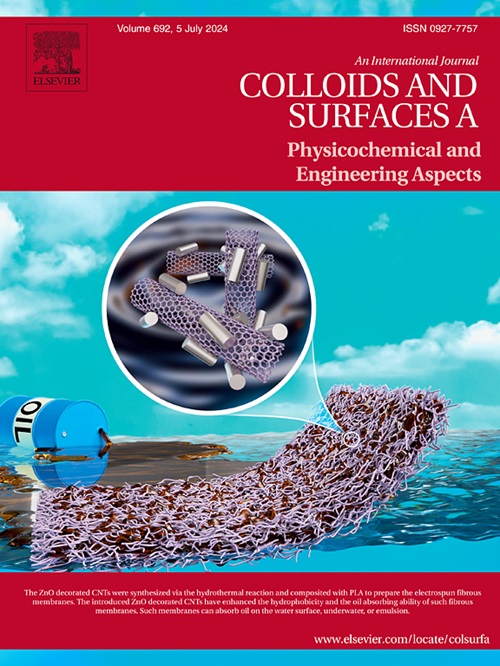Formation mechanism of Fe-based multi-catalysts for growing CNTs
IF 4.9
2区 化学
Q2 CHEMISTRY, PHYSICAL
Colloids and Surfaces A: Physicochemical and Engineering Aspects
Pub Date : 2024-10-28
DOI:10.1016/j.colsurfa.2024.135654
引用次数: 0
Abstract
The application of carbon nanotubes in materials science is rapidly expanding, leading to an increasingly urgent demand for large-scale synthesis. Central to the growth of carbon nanotubes is the development of effective catalysts; thus, the large-scale production of these catalysts becomes crucial for successful carbon nanotube synthesis. Extensive research has been conducted on the mechanisms and regulation of interfacial interactions between metals and supports during catalyst synthesis. This paper is based on the interface interactions between common metal catalysts such as Fe, Co, Ni, and Al2O3, and Fe-Co, Fe-Ni, and Fe-Co-Ni metal catalysts were prepared by a one-step method. The catalysts were synthesized through a "one-step process," and the formation mechanisms of bimetallic and trimetallic catalysts, as well as the influence of interfacial interactions on catalyst formation and catalytic activity, were thoroughly investigated. The results indicate that with the involvement of Fe, Co and Ni on the surface of Al2O3 maintain a small size morphology due to interfacial interaction. Meanwhile, the nanoparticles form a doped structure with Al2O3, effectively avoiding the deactivation of nanoparticles caused by agglomeration. In addition, the three catalysts for growing CNTs were analyzed in order to investigate the effects of different concentrations of metal ratios and time of carbon source on the catalytic activity, which provides new ideas for improving the catalyst design system.
用于生长 CNT 的铁基多元催化剂的形成机理
碳纳米管在材料科学中的应用正在迅速扩大,导致对大规模合成的需求日益迫切。碳纳米管生长的核心是开发有效的催化剂;因此,大规模生产这些催化剂对于成功合成碳纳米管至关重要。人们对催化剂合成过程中金属与载体之间界面相互作用的机理和调控进行了广泛的研究。本文基于常见金属催化剂如 Fe、Co、Ni 和 Al2O3 之间的界面相互作用,采用一步法制备了 Fe-Co、Fe-Ni 和 Fe-Co-Ni 金属催化剂。通过 "一步法 "合成了催化剂,并深入研究了双金属和三金属催化剂的形成机理,以及界面相互作用对催化剂形成和催化活性的影响。结果表明,在铁的参与下,Al2O3 表面的 Co 和 Ni 因界面相互作用而保持小尺寸形态。同时,纳米颗粒与 Al2O3 形成掺杂结构,有效避免了纳米颗粒因团聚而失活。此外,还对生长 CNT 的三种催化剂进行了分析,以研究不同浓度的金属配比和碳源时间对催化活性的影响,为改进催化剂设计体系提供了新思路。
本文章由计算机程序翻译,如有差异,请以英文原文为准。
求助全文
约1分钟内获得全文
求助全文
来源期刊
CiteScore
8.70
自引率
9.60%
发文量
2421
审稿时长
56 days
期刊介绍:
Colloids and Surfaces A: Physicochemical and Engineering Aspects is an international journal devoted to the science underlying applications of colloids and interfacial phenomena.
The journal aims at publishing high quality research papers featuring new materials or new insights into the role of colloid and interface science in (for example) food, energy, minerals processing, pharmaceuticals or the environment.

 求助内容:
求助内容: 应助结果提醒方式:
应助结果提醒方式:


